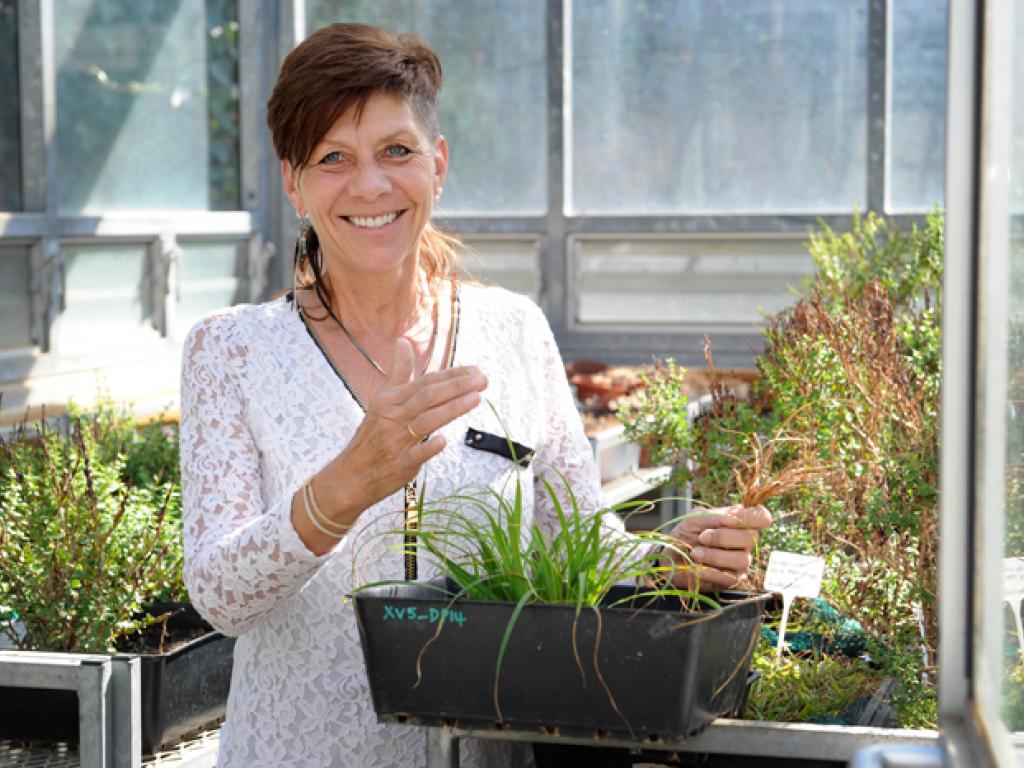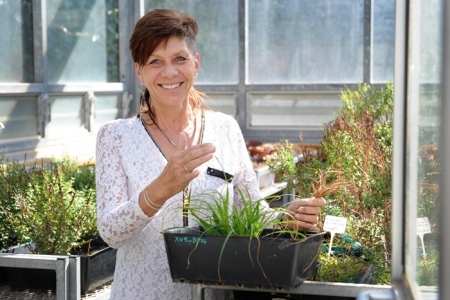New smart crops to underpin food security in Africa


Professor Jill Farrant has studied how resurrection plants can survive in the face of extreme water loss, aiming to introduce these characteristics into smart crops that will feed Africa in the face of climate change and increasing and extended drought.
If you walk by plant molecular physiologist Professor Jill Farrant’s laboratories, you’ll see row on row of bright green plants which are close relatives of tef, or love grass. Tef is an orphan crop in South Africa (we feed it to cattle), but its highly nutritious seeds – which are gluten free – serve as the main food source in countries like Ethiopia.
Its ‘resurrection’ relative is being analysed by Farrant’s students to identify the properties that make this species more drought tolerant than tef, and to use this knowledge to boost its resilience during prolonged dry seasons.
“Drought will affect our crops, whether it’s wheat in the Western Cape or, more importantly, our maize belt in the centre of the country or elsewhere in Africa where it’s the biggest staple crop,” said Farrant.
Under severe drought, crops can no longer resist water loss and under extreme pressure they die after just a small water loss.
“There are no crops we yet know of that can lose an extreme amount of water (desiccation) and not die. Increasing and prolonged droughts will threaten the very base of the food chain.”
If climate change continues unchecked, it is predicted that by 2050 most of South Africa (and the global south) will be desert.
“We need to start identifying strategies now to grow more smart crops,” said the A-rated National Research Foundation researcher.
Smart crops, like tef, are the answer. But in South Africa, farmers grow tef to feed animals.
“My father grew tef to feed our dairy and beef herds in Limpopo,” said Farrant.
The farm was also where Rupert Farrant introduced his inquisitive daughter to a miracle of nature. At the age of nine, Farrant identified what are now called resurrection plants: Xerophyta retinervis and other Xerophyta species that can desiccate without dying.
Farrant never forgot the wonder of watching seemingly dead plants turn green almost overnight, regaining full life in all existing tissues within 12 to 72 hours after rain. The drought-tolerant genetics of resurrection plants came to underpin her life’s work.
She is now looking at a tef plant with bigger seeds and a ‘dwarf’ profile: a plant that doesn’t grow too tall, so that the heads don’t lodge (fall to the ground) when heavy with seeds, which makes harvesting difficult and reduces yields.
Plant survivors
In her research, Farrant has shown that the genetic survival mechanisms found in resurrection plants are like the desiccation processes found in seeds.
“All our crops produce desiccated seeds and thus have the genetic mechanisms to make seed tissue dry without them dying.”
What resurrection plants appear to be doing, said Farrant, is “turning on” those seed genes in their roots and leaves when faced with a severe drought.
The challenge is to unlock these mechanisms that resurrection plants use to turn on these genes in their roots and leaves and use this knowledge to induce the same process in dry times to make crop plants more tolerant of drought.
Desiccation tolerance is a complex phenomenon involving both “switching on” and “switching off” many genes. These are controlled by master switches and her group, in collaboration with Dr Henk Hilhorst of Wageningen University & Research (WUR) in the Netherlands, have identified at least two that seem to play a significant role in the acquisition of desiccation tolerance in a plant.
By understanding how these operate in the vegetative tissue of desiccation plants reacting to loss of water, Farrant hopes to enable the same reaction in crops.
Feeding Africa
Important headway is being made. A paper in the latest edition of Nature Plants has published the genome sequence of Xerophyta viscosa – the work was done by an international consortium that includes Farrant and is led by Hilhorst of WUR (who raised most of the funding for the project).
The paper details the genetic footprint of the resurrection plant’s ability to withstand severe drought for long periods. They hope the finding will contribute to faster development of food crops resilient enough to cope with foreseen global climate change and growing world population.
“Resurrection species such as Xerophyta viscosa may serve as ideal models for the ultimate design of crops with enhanced drought tolerance,” Hilhorst said.
The paper’s first author, Maria-Cecilia Costa, pointed out that Xerophyta viscosa was also able to suppress drought-related senescence (ageing) and that genes involved in seed dormancy, a process that allows seeds to survive many years of dry storage, are also involved.
Adopt orphan crops
In pursuing this research in South Africa, Farrant’s focus is on orphan crops – crops that haven’t taken off commercially on a large scale. Apart from tef, these include local varieties of beans, which are an important source of protein in Africa.
“Cowpea, black-eyed peas and bambara beans are excellent sources of protein that can be grown quickly, with high yields.”
The other concept she is investigating is the biofortification of crops: enriching plants with, for example, vitamin A and an available source of iron to reduce deficiencies common in Africa that result in conditions such as blindness.
Commercially, she’s also keen to see the bio-economy grow in lean times. Plants like Myrothamnus flabellifolia, a woody plant that grows in rock crevices in dry parts of southern Africa, is a particularly promising candidate. Ground into leaves for tea, it offers potent antioxidant and antibacterial properties.
“We must grow our bio-economy using our amazing plant diversity. As we are increasingly understanding the roles of microbiota and field environments, the treasure trove of knowledge is just growing.
“Nature has all the answers.”
Time and money
But time is running out and big money is needed to drive this research.
Farrant and Hilhorst believe that with enough financial backing, they can get to a proof-of-concept plant that will yield an extremely drought-tolerant crop.
“But it will take another five to 10 years before all the biosafety concerns have been addressed to release it out into the wild. So, even with money, it will be at least 15 to 20 years before we even taste the fruit of my work – and that’s the fast track.
“But I’m very patient.”
Food and water go hand in hand as important collaborative research fields.
“Though plants form the basis of the food chain, they don’t survive without water and in Africa 85% of agriculture is based on rainfall,” said Farrant. “Africa needs to invest in desalination and alternative water sources. We need a combined effort by water and plant researchers, augmented by new, creative water-harvesting and irrigation techniques.
“And we must look to nature for ideas on how to trap water.”
Story Helen Swingler. Photo Michael Hammond.
